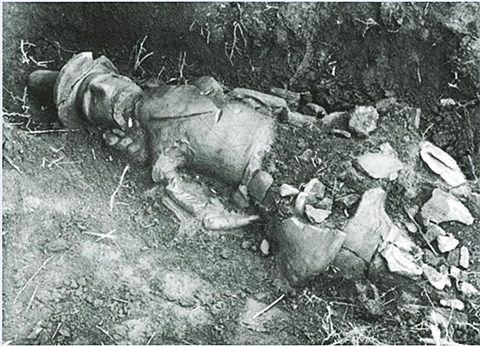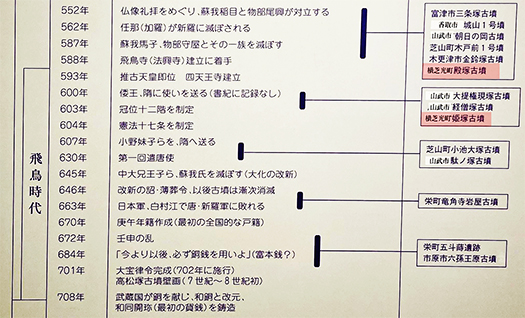

東北大学の田中英道先生(日本の美術史家、歴史家。東北大学名誉教授。)の古代ユダヤの民の日本渡来説は非常に興味深く、蓋然性もあると思える説だと思っているのですが、凡人としてはやはりやや飛躍感があって、もう少し学術的な検証が進んで欲しいと思っているところ。
田中先生がその根拠として強く指摘されているのが、千葉県芝山町にある「芝山古墳・はにわ博物館」に収蔵されている殿塚古墳・姫塚古墳の「埴輪」群であります。ことし念願叶って参観することができた次第。こちらの展示についても写真撮影などが許諾されていたので、それを復習しつつ、田中先生の浪漫あふれる説を考えて見たい。
いちばん上の写真は展示のメインとでも言えるような復元男子像。その下の写真は昭和31年の古墳発掘調査での「武人埴輪」の出土状況。6世紀後半と年代特定されている埴輪像。
つば広の帽子(冠)を被り、長い独特の「下げ美頭良【みずら〜美豆良とも】」を結っている。この髪型は大和時代に始る男子の髪型の一つ。髪を頭の中央で左右に分け,両耳のあたりで束ねて輪状に結ぶ。結び目に櫛を挿す場合もある。
そしてこの男子の埴輪に豊かなあごひげを蓄える姿は、芝山はにわの典型的スタイル。
田中先生の説ではこの風貌スタイル、とくに「つば広」の帽子という特徴についてこれを古代ユダヤの風俗の特徴として挙げられて大きな自説の根拠にされているのですね。たしかに長く日本人はちょんまげなど髪の毛を結いあげて、その頭を烏帽子などの帽子で保護するという風俗文化を続けてきた。この烏帽子などの文化は中国大陸からの影響とも言われているけれど、つば広という形状はきわめて独特と思える。

日本史年表とこの古墳群を対照させると上の表のようになる。6世紀、500年代後半期にあたっていて、中央では蘇我氏の支配が最盛期とも思われる時期に相当する。こういった歴史段階でこの房総の地で国造ほどの地域権力を獲得していた氏族がこの古墳の一族なのでしょう。
関東の中でも房総の地は三浦半島からの海路でひと渡りであり、畿内地域から関東を目指すとすれば、古代ではメインルート上に位置する。そういうことで、房総地域では古墳が関東でももっとも造営されていた。関東のもっとも先進的な地域という認識があったことは間違いがない。そういう地域で勢力を持ち、前方後円墳という最新文化形式導入でヤマト王権中央との強い連携を持ち得た氏族ということになる。
中国大陸では秦の始皇帝を生んだ秦氏の一族がヤマト王権からこの地域の開発・支配を認められて入植した可能性はあるだろう。この時代、日本列島は東アジア最大のフロンティアであったことは事実。この秦氏がユダヤ民族の一族ではないか、というのが田中先生の説の概要。
京都太秦が有名だけれど、秦氏はたしかに日本列島社会に波状的に移民は繰り返していたことは事実なのでしょう。ちょっとこの説を自分なりに考えて見たいブログシリーズであります。以降あしたに続く。
English version⬇
A Jewish Tomb of Nazo descent? Kanto Settlement, Chiba Shibayama Kofun Tomb Exploration-1
The unique haniwa terra-cotta tombs of Shibayama, Chiba Prefecture, are known for their mysterious formations. We finally visited the exhibition “Shibayama Kofun Haniwa Museum”. A surprising visit to the ancient history. The museum is located in the center of Chiba Prefecture.
Dr. Hidemichi Tanaka of Tohoku University (Japanese art historian and historian. Professor Emeritus of Tohoku University.) However, as an ordinary person, I still feel that it is a bit of a leap, and I would like to see more academic verification of the theory.
As a basis for this theory, Dr. Tanaka strongly points out a group of haniwa (clay figurines) from the Tonozuka and Himezuka burial mounds, which are stored in the “Shibayama Kofun Haniwa Museum” in Shibayama Town, Chiba Prefecture. I was able to visit the museum this year. I was allowed to take photos of this exhibition, so I would like to review them and consider Mr. Tanaka’s romantic theory.
The top photo is a restored male figure, which could be called the main part of the exhibition. The photo below shows a “warrior haniwa” (clay figurine) excavated during the excavation of a burial mound in 1956, which is dated to the latter half of the 6th century.
He wears a wide-brimmed hat (crown) and wears a long, unique “mizura” hairstyle. This hairstyle was one of the first boys’ hairstyles in the Yamato period. The hair is parted in the center of the head and tied in a loop around the ears. In some cases, a comb is inserted into the knot.
This male haniwa with a full beard is typical of the Shibayama haniwa style.
In his theory, Dr. Tanaka cites this style of appearance, especially the “wide-brimmed” hat, as a characteristic of ancient Jewish customs, and uses it as the basis for his own theory. It is true that Japanese people have long continued the custom of tying up their hair in a bun and protecting their heads with a hat such as a crow’s-bill hat. This culture is said to have been influenced by the Chinese culture, but the wide-brimmed hat seems to be unique to the Japanese culture.
The above table shows the chronology of Japanese history and these tumuli, which correspond to the late 500s of the 6th century, the period when the Soga clan’s rule was at its peak in the central part of Japan. The family of this tumulus must have been one of the clans that gained as much regional power as the Kunizukuri in the Boso region at this stage of history.
In the Kanto region, the Boso region is one crossing by sea from the Miura Peninsula, and if one were to go from the Kinai region to the Kanto region, it would be on the main route in ancient times. For this reason, the Boso area had the most burial mounds in the Kanto region. There is no doubt that the Boso area was recognized as the most advanced region in the Kanto region. The Yamato clan was powerful in such an area and had strong ties with the central Yamato royal authority in the form of the front-recessed circular mounds.
It is possible that the Qin clan, which gave birth to Qin Shi Huangdi on the Chinese continent, was allowed by the Yamato kingdom to develop and control this region and settled there. It is true that the Japanese archipelago was the largest frontier in East Asia during this period. Dr. Tanaka’s theory is that the Hata clan may have been a member of the Jewish tribe.
The Hata clan is well known in the Kyoto area, and it is true that they repeatedly immigrated to the Japanese archipelago in waves. This is a blog series in which I would like to consider this theory in my own way. To be continued tomorrow.
Posted on 11月 29th, 2023 by 三木 奎吾
Filed under: 未分類







コメントを投稿
「※誹謗中傷や、悪意のある書き込み、営利目的などのコメントを防ぐために、投稿された全てのコメントは一時的に保留されますのでご了承ください。」
You must be logged in to post a comment.